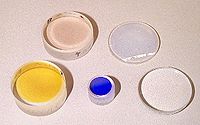
Photo from wikipedia
Abstract Quaternary chalcogenide Cu2FeSnS4 (CFTS) thin films were successfully elaborated by spray pyrolysis technique on glass substrates using different thiourea concentrations (4, 5, 6 and 7.10−2M) as sulfur source. The… Click to show full abstract
Abstract Quaternary chalcogenide Cu2FeSnS4 (CFTS) thin films were successfully elaborated by spray pyrolysis technique on glass substrates using different thiourea concentrations (4, 5, 6 and 7.10−2M) as sulfur source. The chemical composition, morphological, structural, optical and electrical properties were investigated using respectively dispersive X-ray spectrometry (EDX), scanning electron microscopy (SEM), X-ray diffraction (XRD), Raman spectroscopy, spectrophotometer and Hall Effect measurements. XRD and Raman spectroscopy revealed that CFTS thin films synthesized at thiourea concentration [S] = 6.10−2M grows with a pure and good crystalline quality. CFTS thin layer crystallized into the stannite structure with the preferred orientation (112) plan. The average grain size reaches a maximum value about 41 nm at [S] = 6.10−2M. The obtained CFTS stoichiometric ratio was Cu:Fe:Sn:S = 2,25/1/0,91/4,08 which is close to the theoretical ratio 2:1:1:4. Optical properties present a high absorption coefficient value equal to 8 104 cm−1, with an estimated band gap value 1,05 eV. This work demonstrates also that electrical resistivity was about 0,46 Ω cm at room temperature and has been decreased to a minimum value of 0,014 at 80 °C. All these experimental results make sprayed CFTS thin film synthesized at [S] = 6.10−2 M as a promising absorber layers in solar devices. Methylene Blue dye under sun illumination has been used to test to photocatalytic activity of optimum CFTS thin film. A value of photo-degradation near 76% of MB dye has been obtained for 4 h duration. This result show that CFTS thin film synthesized at [S] = 6.10−2 M is a good candidate for photocatalysis applications.
Journal Title: Superlattices and Microstructures
Year Published: 2018
Link to full text (if available)
Share on Social Media: Sign Up to like & get
recommendations!